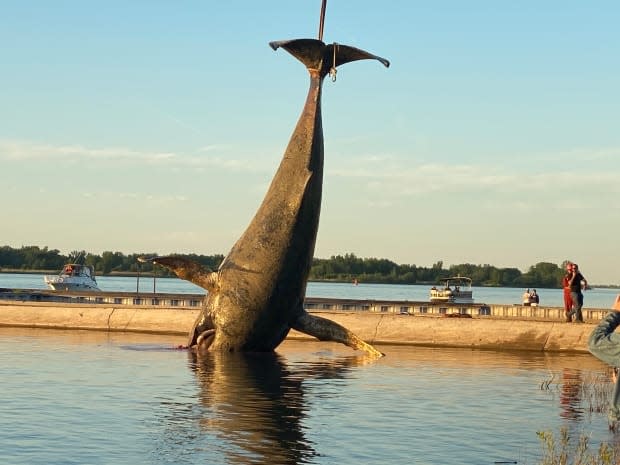Remember the whale that wowed Montrealers last spring? Its visit, death, remain a mystery
Last spring, a humpback whale piqued the curiosity and captured the hearts of Montrealers during a brief passage through the St. Lawrence River.
The whale swam from the town of Tadoussac, to Quebec City, before ending up under the Jacques-Cartier Bridge.
During its stay in Montreal, the whale attracted large crowds near the river before its lifeless body was spotted near Varennes, Que.
Months later, evidence supporting what researchers believe happened is still hard to come by.
The Group for Research and Education on Marine Mammals and the Centre québécois sur la santé des animaux sauvages released a report on the whale's journey.
Researchers initially thought the whale was hit by a boat, but they say the state of its body and the extent to which it had been manipulated made it difficult to analyze and determine the collision was the cause of death. Several of its organs were missing at the time of the necropsy, the report stated.
"The autopsy conducted on the humpback didn't allow us to confirm this hypothesis," read a statement from Stéphane Lair, the veterinarian who oversaw the procedure.
"We can think that its prolonged exposure to soft waters hampered its physiological functions."
Their research did lead them to believe the whale died quickly and suddenly, since, according to them, it had not shown signs it was getting weaker or losing an abnormal amount of weight due to lack of nutrition.

Why did it go to Montreal?
The research team says it's looking at different theories to explain why the humpback whale was out of its usual, salt water habitat. The most reasonable one, according to them, is that of "exploratory behaviour" which is sometimes observed among young mammals.
They don't believe the whale was suffering from an ailment or a condition that made it confused as to where it was and where it was going.
The report acknowledges that more information is needed on how humpback whales behave in unfamiliar territory, and how to intervene.
"This visit reminded us that we share the St. Lawrence with fragile giants and shed light on several issues of cohabitation, such as disturbance, sound pollution and collision risks," said Robert Michaud, a co-ordinator with Group for Research and Education on Marine Mammals.

